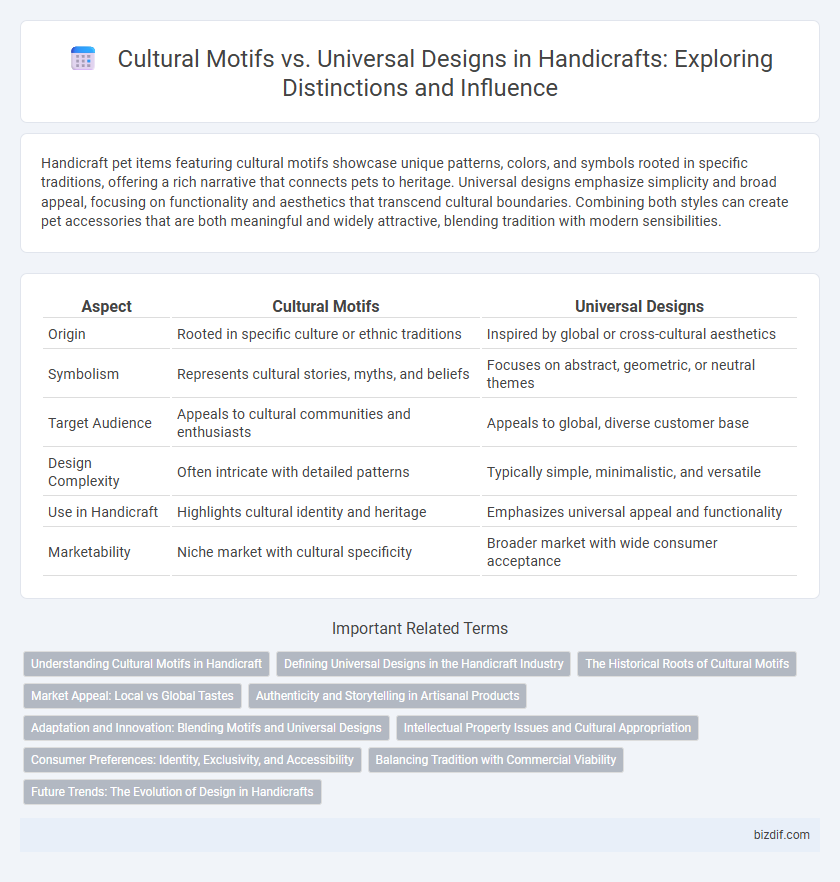Handicraft pet items featuring cultural motifs showcase unique patterns, colors, and symbols rooted in specific traditions, offering a rich narrative that connects pets to heritage. Universal designs emphasize simplicity and broad appeal, focusing on functionality and aesthetics that transcend cultural boundaries. Combining both styles can create pet accessories that are both meaningful and widely attractive, blending tradition with modern sensibilities.
Table of Comparison
| Aspect | Cultural Motifs | Universal Designs |
|---|---|---|
| Origin | Rooted in specific culture or ethnic traditions | Inspired by global or cross-cultural aesthetics |
| Symbolism | Represents cultural stories, myths, and beliefs | Focuses on abstract, geometric, or neutral themes |
| Target Audience | Appeals to cultural communities and enthusiasts | Appeals to global, diverse customer base |
| Design Complexity | Often intricate with detailed patterns | Typically simple, minimalistic, and versatile |
| Use in Handicraft | Highlights cultural identity and heritage | Emphasizes universal appeal and functionality |
| Marketability | Niche market with cultural specificity | Broader market with wide consumer acceptance |
Understanding Cultural Motifs in Handicraft
Cultural motifs in handicraft embody the unique symbols, patterns, and narratives rooted in a specific community's heritage, reflecting centuries of tradition and localized artistry. These motifs carry deep meanings and often signify beliefs, history, and identity unique to that culture, distinguishing them from universal designs that emphasize broader, more generic aesthetics. Understanding cultural motifs involves recognizing their origin, symbolism, and techniques, which preserves authenticity and promotes cultural appreciation in handcrafted works.
Defining Universal Designs in the Handicraft Industry
Universal designs in the handicraft industry refer to patterns and motifs that transcend specific cultural origins, appealing to a wide global audience through their simplicity, symmetry, and timeless aesthetics. These designs prioritize functionality and inclusivity, ensuring that handicraft products meet diverse consumer needs while maintaining artistic integrity. By integrating universal elements, artisans can create pieces that resonate across different cultures, enhancing marketability and fostering cross-cultural appreciation.
The Historical Roots of Cultural Motifs
Cultural motifs in handicrafts originate from deeply rooted historical contexts, often symbolizing religious beliefs, social status, or community identity unique to specific regions. These motifs carry centuries-old narratives and traditional techniques passed down through generations, reflecting the values and heritage of their cultures. Unlike universal designs, which prioritize aesthetic appeal and broad usability, cultural motifs preserve distinct historical significance and localized craftsmanship.
Market Appeal: Local vs Global Tastes
Cultural motifs in handicrafts showcase rich heritage and traditional symbolism, resonating deeply with local markets seeking authentic and meaningful designs. Universal designs, characterized by minimalism and neutral aesthetics, appeal broadly to global consumers who prioritize versatility and contemporary style. Balancing these elements enables artisans to expand their market reach while preserving cultural identity.
Authenticity and Storytelling in Artisanal Products
Cultural motifs in handicrafts embody rich authenticity and deep storytelling, reflecting specific traditions, histories, and identities unique to particular communities. Universal designs, while broadly appealing and versatile, often prioritize aesthetic harmony and functionality over localized narratives. Artisanal products featuring culturally rooted motifs offer customers meaningful connections and preserve intangible heritage, enhancing the perceived value of handmade crafts.
Adaptation and Innovation: Blending Motifs and Universal Designs
Handicraft artisans adapt cultural motifs by seamlessly blending them with universal design principles to create innovative products that resonate with diverse audiences. This fusion enhances aesthetic appeal while preserving traditional symbolism, enabling broader market acceptance and cultural exchange. By integrating distinctive patterns with modern forms, crafts gain renewed relevance in contemporary design landscapes.
Intellectual Property Issues and Cultural Appropriation
Cultural motifs in handicrafts are deeply rooted in indigenous traditions and often hold spiritual or historical significance, making their use sensitive under intellectual property laws, which struggle to protect collective cultural heritage. Universal designs, while widely adaptable and less likely to infringe on specific cultural rights, may lack the authenticity that distinguishes traditional handicrafts, leading to debates on cultural appropriation when motifs are adopted without permission or attribution. The ethical challenge lies in respecting the origin communities' rights and ensuring fair benefit-sharing while fostering creativity and market access in the global handicraft industry.
Consumer Preferences: Identity, Exclusivity, and Accessibility
Consumers of handicrafts often seek cultural motifs that reflect their identity and heritage, valuing exclusivity and the story behind each piece. Universal designs appeal to a broader market by offering accessibility and versatility, making them suitable for diverse tastes and settings. Preference trends reveal a balance between authentic cultural expression and practical design adaptability, influencing purchasing decisions in artisanal markets.
Balancing Tradition with Commercial Viability
Cultural motifs in handicraft preserve heritage by showcasing region-specific symbols, patterns, and techniques that resonate deeply with local identities and craftsmanship traditions. Universal designs prioritize broad market appeal, employing neutral or globally recognized aesthetics that facilitate wider commercial viability and export potential. Balancing tradition with commercial viability requires integrating authentic cultural elements into adaptable product forms that attract diverse consumers while sustaining artisans' unique cultural expressions.
Future Trends: The Evolution of Design in Handicrafts
Cultural motifs in handicrafts preserve heritage through intricate patterns rooted in specific regions, while universal designs emphasize simplicity and global appeal driven by contemporary aesthetics. Future trends indicate a fusion of these elements, integrating traditional craftsmanship with innovative materials and digital techniques to appeal to both local authenticity and international markets. Advancements in sustainable practices and customizable artisan products are set to redefine the evolution of design in handicrafts, supporting cultural preservation and modern consumer demands.
Cultural motifs vs Universal designs Infographic

 bizdif.com
bizdif.com